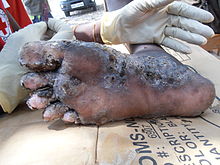Tunga penetrans
| Tunga penetrans | ||||||||||
|---|---|---|---|---|---|---|---|---|---|---|

Tunga penetrans female after surgical removal |
||||||||||
| Systematics | ||||||||||
|
||||||||||
| Scientific name | ||||||||||
| Tunga penetrans | ||||||||||
| Linnaeus , 1758 |
Tunga penetrans is a flea from the family of sand fleas (Tungidae). It can be found in the tropical regions of America (original homeland), Africa and Asia. Like other fleas, it is a parasite and affects mammals. The infestation iscalled tungiasis and is a harmless, if disturbing disease. However, as the parasite penetrates under the skin, other microorganisms can infiltrate the tissue, which can lead to secondary infections . In addition to ulcerations , infection with Clostridium tetani is particularly dangerous.
features
The animals are one to two millimeters long and have a laterally flattened body. Like all fleas, they are wingless, but have hind legs developed into jump legs.
The male reaches a size of 0.5 to 0.7 millimeters, the female 0.5 to 6 millimeters when fully sucked. The preferred hosts are humans and large domestic animals.
Way of life
Tunga penetrans lives on sandy soils. They feed parasitically on the blood of various mammals, including humans. The female digs into the host's skin (mainly on the feet and under the toenails) and grows to a size of four to twelve millimeters in diameter within 8 to 10 days. The parasite can then be palpated as a papulo-nodular structure, possibly a small opening can be observed, whereby part of the abdomen with the oviduct and the stigmas can protrude above the skin level. Mating takes place only here via males who move above the skin level. The female secretes a few thousand eggs, which fall to the ground and develop into pupae and adult fleas in about 3 weeks via larvae (after about three to four days) . The female dies stuck in the host's body.
See also
Web links
- Tunga penetrans in FA Bisby, YR Roskov, MA Ruggiero, TM Orrell, LE Paglinawan, PW Brewer, N. Bailly, J. van Hertum, eds (2007): Species 2000 & ITIS Catalog of Life: 2015 Annual Checklist .
- Periungual Tungiasis Muehlstaedt M (2008) Images in clinical medicine. Periungual tungiasis. N Engl J Med 359 (24): e30.
- anti-jigger campaign engl. Campaign against sand fleas
Individual evidence
- ↑ J.-C. Beaucournu, B. Degeilh, T. Mergey, S. Muñoz-Leal, D. González-Acuña: Le genre Tunga Jarocki, 1838 (Siphonaptera: Tungidae). I - taxonomy, phylogénie, écologie, rôle pathogène . In: Parasite . 19, No. 4, 2012, ISSN 1252-607X , pp. 297-308. doi : 10.1051 / parasite / 2012194297 .
- ↑ Pedro Marcos Linardi, Jean-Claude Beaucournu, Daniel Moreira de Avelar, Sorya Belaz: Notes on the genus Tunga (Siphonaptera: Tungidae) II - neosomes, morphology, classification, and other taxonomic notes . In: Parasite . 21, 2014, ISSN 1776-1042 , p. 68. doi : 10.1051 / parasite / 2014067 . PMID 25514594 .
